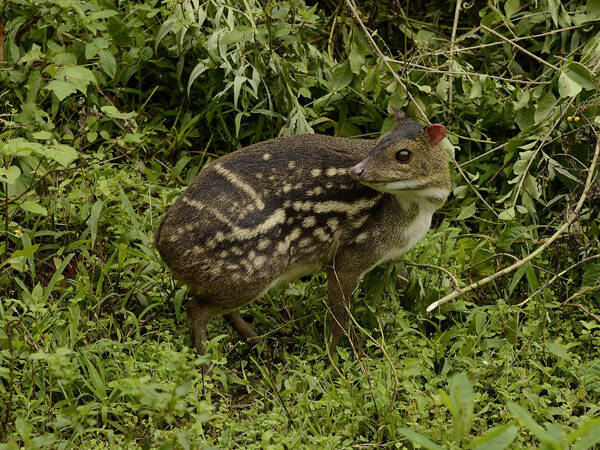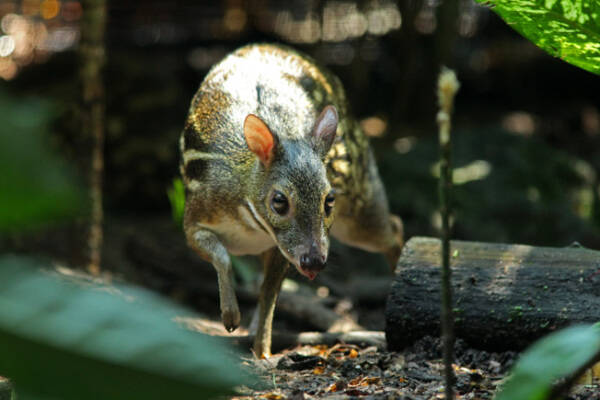Moschiola meminna
IUCN
LCBasic Information
Scientific classification
- name:Moschiola meminna
- Scientific Name:Moschiola meminna, White-spotted Chevrotain,Chevrotain,Indian Mouse Deer,Indian Spotted Chevrotain,White-spotted Mousedeer,Tragule d'Inde, Meminna
- Outline:Ungulata
- Family:Artiodactylus Tragopanidae Tragopanidae
Vital signs
- length:Shoulder height 20-40 cm
- Weight:About 3kg
- lifetime:8-12years
Feature
It is the "treasure of the town" of Singapore Zoo.
Distribution and Habitat
The newly classified spotted chevrotain (Moschiola meminna) is endemic to the dry zone of Sri Lanka: it most likely occurs throughout the region. This covers most of the island, except in the southwestern zone and the central mountains. The assumption of a strict habitat segregation between this species and the yellow-striped chevrotain (M. kathygre) requires objective identification (i.e. not only based on habitat and location) of other animals in different parts of the island.
The spotted chevrotain is fairly common in forests throughout the dry zone, both within and outside protected areas. Typically occupying a range of habitats from evergreen forests to plantations, it is common not only in all forest types in the dry zone, including evergreen, semi-evergreen and deciduous forests, but also in grasslands and commercial plantations (coconut plantations) and domestic gardens.
Appearance
The shoulder height of the chevrotain is 20-40 cm, and the average weight is 3 kg, with males being smaller than females. No sexual dimorphism in skull and skeletal measurements has been found in this species. Their limbs are short and slender with four-toed feet. Fur color varies from species to species. The fur on the back is medium to dark brown, the belly is white, and there are 4-5 light vertical stripes or spots on the back. The chevrotain has large eyes. The difference from the other two species is the preorbital vacancy between the maxilla, frontal bone and lacrimal gland. Their auditory bullae are also more rounded.
All chevrotain species share the skull characteristics of a relatively straight skull axis, a closed postorbital bar, and the absence of horns or antlers. The upper incisors are missing, and the upper canines of males are enlarged and continuously growing, used for intraspecific fighting. The tooth formula is 0/3 1/1 3/3 3/3 = 34.
Details
Spotted Mouse Deer (scientific name: Moschiola meminna) English White-spotted Chevrotain, Chevrotain, Indian Mouse Deer, Indian Spotted Chevrotain, White-spotted Mousedeer, French Tragule d'Inde, Spanish Meminna, no subspecies.

In 2005, Groves and Meijaard revised the name "Moschiola meminna", who restricted the animals to the arid regions of Sri Lanka. Prior to this, all populations in the genus Moschiola were considered conspecific, under the name "M. meminna" (as the earliest in the genus), and until Groves and Grubb (1987), usually "Tragulus meminna". The reality of Groves and Mehard's (2005) taxonomic assumption of two distinct species of Moschiola in Sri Lanka, one in the dry and wet regions (and perhaps a third in the montane regions); and another in India, would benefit from independent confirmation: only three skulls from the wet regions were available for critical analysis, making it difficult to assess the significance of their absolute separation from the dry region series. However, since skull differences co-vary with fur and body proportions, their taxonomic proposal is followed here in the hope that doing so will encourage the generation of additional information to consolidate or modify the arrangement. This species is not considered a montane animal.
Moschiola is active exclusively at night. Studies have shown that their choice of habitat may be closely related to the need to provide adequate shelter, dense cover, and food sources. It is a ruminant with a simple three-chambered stomach. Easily digestible foods are selected for rapid fermentation and rapid passage through the intestine, which in turn facilitates rapid and efficient digestion.
The spotted chevrotain is primarily a frugivorous animal, eating easily digestible foods that provide relatively high protein and less fibrous material. It usually forages in the understory and eats fruits that have fallen from trees. Other foods include young leaves, shrubs, young branches, and sometimes animal food found on the forest floor.

The spotted chevrotain, a small forest ungulate, relies on its secretive appearance and dense vegetation cover to avoid detection by predators. They are common prey for jackals (Cuon alpines), tigers (Panthera tigris) and leopards (Panthera pardus). There are also reports of the Forest Eagle Owl (Bubo nipalensis) occasionally preying on the chevaux.
Little is known about the mating system of wild chevaux. Most of the information on the breeding pattern of chevaux comes from captive animals. There is no fixed breeding season for chevaux in captivity, but mating in the wild may occur in different seasons at different locations. In India, the estrus and mating period is June-July. Meetings of two male chevaux during this period may result in fights involving mutual splashing and biting. In captivity, alternative matings between males and the same receptive female suggest that this species may be polygynous. The mating behavior of the Greater Chevaux (Tragulus napu) is more well documented. This species uses a combination of chemical secretions and vocal cues during courtship. During mating, males use their intermandibular glands to mark females by rubbing. Rhythmic vocalizations are usually exchanged before mating. A similar courtship pattern may be observed in spotted chevrotains.
Species of the family Tragopanidae have a postpartum estrus. For spotted chevrotains, the interval between births ranges from 171-289 days, with an average of 219.6 days. The gestation period of the Indian spotted chevrotain (Moschiola indica) is 150-160 days. The litter size observed in captivity is always twins, which are rare. Newborn calves of the Indian spotted chevrotain weigh 288-382 g (average 319 g). The weight of newborn calves is related to the size of the mother. The lactation period varies among chevrotains. Information on lactation in spotted chevaux is scarce, but it has been described as 157 days in the African species Hyemoschus aquaticu and 91 days in the Javan chevaux (Tragulus javanicus) of Southeast Asia. Animals of the family Tragulidae have a lifespan of 8-12 years in the wild. The only recorded lifespan of spotted chevaux in captivity is 6 years and 9 months.

The spotted mouse deer, although it looks like a deer, is not a true deer but an animal belonging to the family of mouse deer. In terms of English etymology, the taxonomic family name and common name of this animal are both related to sheep. This animal is a native species of Sri Lanka and the Indian Peninsula. The chevrotain is the "treasure" of the Singapore Zoo, the only successful case of breeding a chevrotain outside its native range.
Over the past few centuries, the chevrotain has experienced significant loss of habitat and its population, as reflected in the species in Sri Lanka, which went from 1 million in the 19th century to 200,000 in 2008. There are many secure protected areas within the drylands that protect the chevrotain. The impact of forest degradation and fragmentation on this chevrotain may not be severe, given their ability to survive in home gardens, coconut plantations, etc. The Sri Lankan chevrotain was often hunted during the civil war in areas where conservation management was suspended, using firearms to kill them and eat their meat, but this does not seem to be enough to limit the species population and levels to reasonable sized territories and remaining habitat. In the drylands, even outside protected areas, they are still quite common in the forests, although hunting is common. Hunting techniques that can be dangerous to spotted chevaux include the many snares in the forest (usually set for pigs) and live wires.
Listed in the IUCN Red List of Threatened Species in 2014 ver3.1 - Least Concern (LC).
Protect wildlife and eliminate game.
Maintaining ecological balance is everyone's responsibility!








